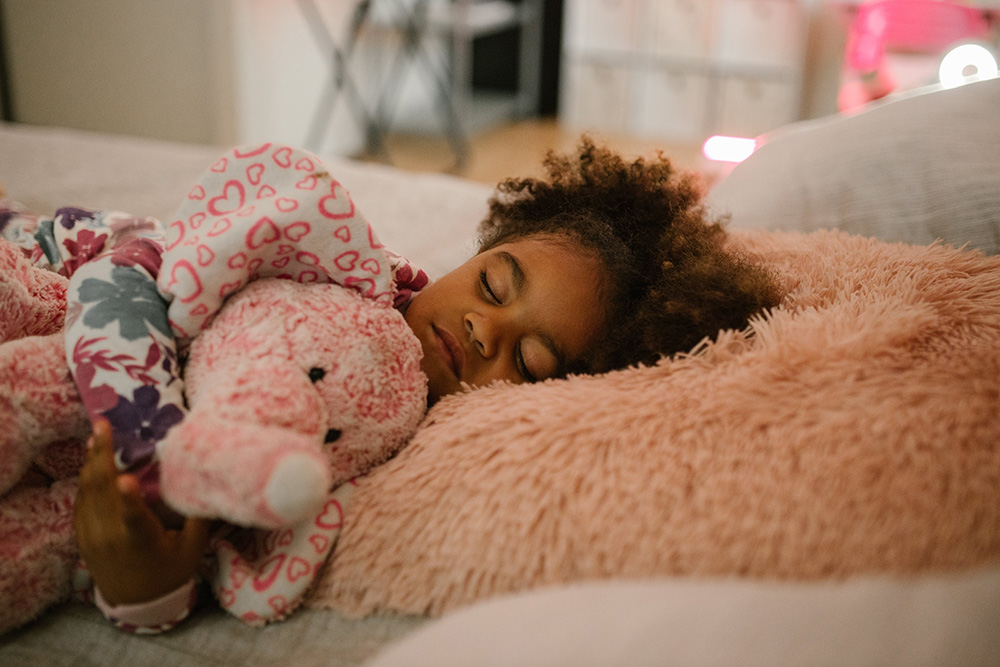Okay, who is ready to tear their hair out with the nighttime bedtime battle? Often, I hear parents complain about their child getting in and out of bed 900 times a night. Or, they spend the night with tiny elbows and knees poking them in the back or landing squarely across their face, even though you never signed up for bed-sharing. If you want to learn some tips and tricks to help navigate those sleepy time struggles and transform your nights into a peaceful slumber, keep reading as we dive into the world of kid-friendly sleep strategies.
1. Establish a Consistent Routine
Remember when you first brought home baby and you were totally exhausted because they had their days and nights all mixed up? If you are like most parents, you spent a good part of the first year trying to get your kiddo to sleep when everyone else sleeps. That meant you likely created some kind of routine that included things like a warm bath, rocking in the rocking chair, maybe reading a story or singing some songs, a final feeding session, and then off to la la land. Eventually, baby got into a rhythm and finally learned that days are for being awake and nights are for sleep.
Somewhere along the way, that schedule and routine got derailed. Now, we have a nightly party happening at around 10 p.m. and EVERYONE is exhausted.
Kids of all ages thrive on routine. So, the first tip in getting a better night’s sleep is to develop a consistent routine. Figure out what time you want your kiddo to officially be lights out and work backward from there. For example, you want an 8 p.m. lights-out bedtime. That means that the nighttime routine probably needs to start somewhere around 7 p.m. Maybe it includes bath time and brushing teeth, followed by two stories, time to cuddle and sing songs, and then hugs/kisses/I love you’s and lights out. Once you have created your ideal scenario then stick to it like glue! Consistency is key. Eventually, it becomes a comforting ritual and both you and your child look forward to the nighttime routine.
2. The Magic of a Bedtime Story
There are so many benefits to reading a nightly bedtime story. First and foremost, it becomes a treasured bonding time. It is a built-in quality one-on-one time with your child that we very often find little time for otherwise.
To go along with the structure from tip #1, it is a built-in structure that offers a comforting predictable routine to the process. Your child will come to learn that the bedtime story signals the end of the day and it helps create a sense of security and structure, making the transition to sleep smoother.
Have you ever really paid attention to the sing-song pattern of children’s books? They are rhythmic and melodic, which offers a soothing effect on your child’s nervous system. This helps to calm their active minds, reduce anxiety, and make it easier for them to drift off.
Perhaps the most enduring gift of the bedtime story is the likelihood of a lifelong love of reading. When you make reading a treasured and positive part of your child’s bedtime routine, you are setting them up for a future of reading enjoyment. I’ve never heard a parent say, “Man, I wish I had never taught my kid to read” or “Shoot, I really wish my kid didn’t like to read – it’s so annoying.” Some of our favorite books in our house across the ages were Goodnight Moon, anything by Sandra Boyton, all of the Skippy John Jones books, and books by Judy Blume.
3. Dim the Lights
Harsh bright lights tend to be extremely stimulating making it a challenge to transition from daytime activity to bedtime relaxation. Therefore, by turning lights down it is a clear signal to the brain that it is time to start winding down. The soft lighting is more comforting and creates a soft, cozy environment.
This is part of the reason why it is recommended to limit screen time 1-2 hours before bed. The blue light that is emitted by screens is made up of a series of flashing lights. Think of it as a tiny little disco ball repeatedly activating the brain and interfering with the production of melatonin (more on that in a second). So, reducing screen time and coupling it with dim lights, emphasizes to the child’s brain and body that it is time to settle down for the night.
Melatonin is a hormone in our bodies that is designed to regulate our natural sleep-wake cycle. A nice little feature that we have built-in is that melatonin production increases in response to darkness. This is just another signal to your kiddo’s body that it is time to sleep. By dimming the lights, you are encouraging melatonin production, thus making it easier to drift off to sleep.
4. Make the Bedroom Cozy
Who doesn’t want to sleep in a nice, warm, cozy room? The more comfortable and peaceful the room is the more likely that your child will stay put. If they stay in there, the more likely they are to go to sleep.
So, how do we make it cozy? Begin by including your kiddo in the process as much as possible. Let them help pick out the décor and color schemes. Soft sheets and plush pillows are super inviting, made even better by being a favorite character, animal, or color. Maybe even add a soft and comfy rug. Cold feet is a no-go and it even makes for a nice spot for those bedtime stories. The darker the room, the better the sleep. Don’t forget those curtains (blackout, if possible) or blinds. However, for those little ones who are afraid of what goes bump in the night, a soft nightlight will help to ease some fears.
Parents often share that they put their child to bed, but a short while later they hear them playing in their rooms. If at all possible, it might be helpful to store toys and games somewhere other than in their room. It will decrease temptation and reason to get out of bed. If that is not possible, the more organized and closed in secure bins the better. This contributes to a sense of calm and tranquility.
5. White Noise Magic
Have you got a light sleeper? Does it seem like the tiniest sound wakes them up? A white noise machine may be the way to go. The soothing sounds can drown out disruptions and help your little one stay asleep.
White noise is made up of audible frequencies at equal intensity. It does not have a specific pattern or melody. Therefore, when it is played at a comfortable volume, it can block other sounds, such as voices or other household sounds. Because of its consistent and predictable pattern, it reduces the impact of sudden noises that might result in being startled awake and promotes more uninterrupted sleep. Additionally, when used as part of the bedtime routine, the sound is associated with sleep and acts as a trigger for relaxation and a cue to fall asleep.
6. Avoid Heavy Meals and Caffeine
Have you ever gone to bed with a full stomach and you are so uncomfortable that you can’t sleep? Children are not unlike adults, in that any discomfort interferes with the calming and relaxation process. Their tiny tummies need the opportunity to digest. To adequately digest our food, enzymes are activated and continue to work hours after eating. This can lead to less time in active, deep, restorative sleep.
So, how do we manage the “I’m huuuunnnnggggrrryyyyy” that seems to pop up right at bedtime? First, it is best to try to time dinner. If you know bedtime is at 8 p.m. (for example), a 5:30-6 p.m. dinner time will likely offer time for digestion. Then, when that “starvation” strikes right when you say it is time for bed, a small snack might be the best option. Easily digested options, like a small bowl of oatmeal or a glass of warm milk, would be the way to go.
As far as caffeine goes, we all know that it is a stimulant. Stimulant is code for activating. To go to sleep, we need the exact opposite of activating – calm and relaxed, right? The problem with caffeine is that it can stay in your body way longer than you think. So, our best option is to try to minimize the amount of caffeine intake as possible. But remember, caffeine can be tricky. Not only is it in soda, coffee, and tea, but it is in chocolate, some medications, or even vitamins that we don’t think about.
7. Use Relaxation Techniques
Relaxation techniques are helpful for managing anxiety, decreasing stress, and promoting better sleep. By teaching the tools to our children, we are showing them that they have the power to calm their minds and bodies. There are many different options, so we will only talk about a couple.
We often tell our children to take a deep breath, particularly when they are upset or out of sorts. What we are telling them is to take slow, deep breaths in through their nose and out through their mouth. Some tips for teaching this might be to use bubbles and tell them to try to blow a bubble as big as their head. It often leads to giggles and happiness, as well as an understanding of the slow, controlled pattern required for effective deep breathing. Another option is to have them lay on their back with a soft toy on their stomach. Have them practice their deep breathing while watching the toy go up and down. Finally, you can ask them to pretend it is their 100th birthday. They need to blow out the candles in one breath so that their wish can come true. If they just blow in a whoosh only a couple of the candles will go out, so the deeper they breathe in and the slower they breathe out, the more candles will go out.
Another option for relaxation is progressive muscle relaxation. This is a tool that helps them identify which muscles in their body are tight. Once they recognize where the tightness is, they can consciously release the tension. Start with their toes and work up to their head, guiding your kiddo to tense and relax each muscle group. For example, have them clench their toes for a few seconds and then release, recognizing the feeling of relaxation that follows.
Finally, they may benefit from the use of positive affirmations. By increasing their positive self-talk, we are decreasing feelings of anxiety. Have them quietly say to themselves, “I am calm,” “I am safe,” “I will have sweet dreams.”
During this time of practicing relaxation strategies, it also might be a good time to have them talk about their day. Take a few minutes to reflect on the events throughout the day, but remember to end on a positive of something that left them feeling grateful.
8. Set a Good Example
Children are always watching and learning. If they see you prioritizing sleep and seeing the value in its importance they will as well. We also know that a well-rested parent makes managing daily stressors and challenges easier. Managing your stress and anxiety better teaches your child tools for doing the same. We all know that better sleep equals better emotion regulation and resilience. Taking care of you sends a message to your child about how essential it is for them as well.
In the world of raising children, sleep is king! Hopefully, these 8 tips and tricks can help make those nighttime struggles a thing of the past. With patience, consistency, and a little white noise magic, your kid will be off to la la land in no time. Sweet dreams to all, and to all a good night!
If you notice that you are still experiencing some bedtime battles or need extra tips for soothing slumber, I can help. Schedule a 30-minute consultation with me today!





